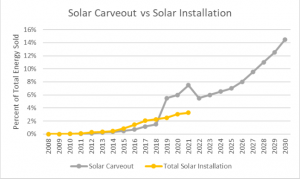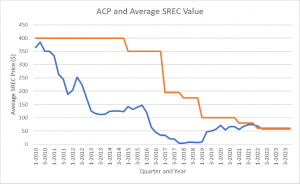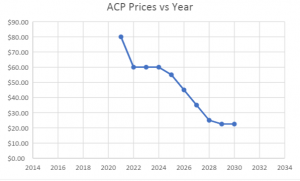Future SREC Prices
A common perception is that the Solar Renewable Energy Credit (SREC) prices are set by the government. This is not true. Actually, SREC prices are set by the electricity market, by buyers and sellers. The buyers are the electricity suppliers and the utilities (offering Standard Offer Service to individuals who have not selected an electricity supplier other than their utility). They are required to present to the Maryland Public Service Commission certification of the number of SRECs bought during the year, which is calculated by multiplying their annual electricity sales by the solar content requirement from the state’s Renewable Portfolio Standard (RPS or commonly called the solar carveout). The electricity supplier, or Standard Offer Service provider, can buy the SRECs on the open market, or, if they are unable to buy the required number of SRECs, they can pay a penalty at a rate set by state law, called the Alternative Compliance Payment (ACP).
During times when solar production is larger than the solar carveout rate, then SRECs will be plentiful, and electricity suppliers (and the Standard Offer Service provider) will get all the SRECs they need from the SREC market. During a time period where there is an overabundance of SRECs available, the price for an SREC would be expected to be low. This occurred during the period of 2016-2018. See Figure 1. During this period the value of an SREC went from about $120 to $5. See Figure 2. In 2019, the Maryland General Assembly changed the solar carveout component of the RPS, and once again, the SREC requirement exceeded its availability. Once the excess SRECs were expended (2020-2021), the price of an SREC quickly increased, ultimately reaching the level of the ACP. This happened in 2022.
A review of Figure 1 shows that, unless there is a solar installation spurt in Maryland, the total solar installation will remain below the solar carve out requirement. If that happens, the value of the SREC will likely remain at the level of the ACP payment. Figure 3 shows future ACP levels currently set by state law (as of August 2022). It is likely that SREC levels will follow the levels of the ACP payments. SREC levels would never be expected to exceed the ACP level as it would be more cost effective for the electricity supplier to pay the lower ACP payment instead of buying a higher priced SREC on the open market.
There are three main factors affecting the value of SRECs:
- Building more solar in Maryland could ensure the total solar installations in Maryland exceeded the solar carveout rate required by the RPS. If that were to happen, the value of SRECs would likely decrease
- The legislature could adjust the solar carveout requirement of the RPS. Raising the solar carveout requirement would ensure the SREC value remained essentially equal to the ACP rate. Lowering the solar carveout requirement could ensure more SRECs were produced than are required, placing the market in an oversupply status, thus lowering the value of a given SREC.
- The legislature could adjust the level of ACP payments. Raising the ACP would raise the value of an SREC in an undersupplied market, but would have little effect on SREC value in a market with SREC oversupply.
Figure 1: Solar Carveout and Solar Installation vs. Time
Source: Solar Carveout: Section 7-705 of the Maryland Public Utilities Article
Source: Total Solar Installation: PJM GATS database “Renewable Generators Registered in GATS”
gats.pjm-eis.com/gats2/PublicReports/RenewableGeneratorsRegisteredinGATS
Figure 2: ACP and Average SREC Value vs. Time
Source: ACP Levels: Section 7-705 of the Maryland Public Utilities Article
Source: SREC values over time: Compiled from data from Fleet Exchange Environmental Markets flettexchange.com/markets/srec/maryland/historical-data
Figure 3: Future ACP Price vs Time
Source: ACP Levels: Section 7-705 of the Maryland Public Utilities Article
This article uses assumptions that simplify the workings of the SREC market, and as such, SREC values may differ from the statements in this article.




 1-888-373-7888
1-888-373-7888 233733
233733